Disclaimer: As a Chewy and Amazon affiliate, I earn from qualifying purchases. This does not impact our reviews and comparisons.
How much should I feed my cat?
Most cats need 190 -280 calories/day.
Check the cat food label for feeding recommendations based on your cats weight.
The goal is to keep your cat a balanced weight. Aim for a 5 on the body condition score chart to keep your cat healthy.
In this article I’ll go through factors to consider when feeding your cat, guidelines for feeding, and signs you’ve fed your cat too much.
I’ll also cover frequently asked questions on this topic.
Let’s go.
I am not a veterinarian and I recommend seeking the advice of a vet for any further questions. The advice in this article is not intended as medical advice.
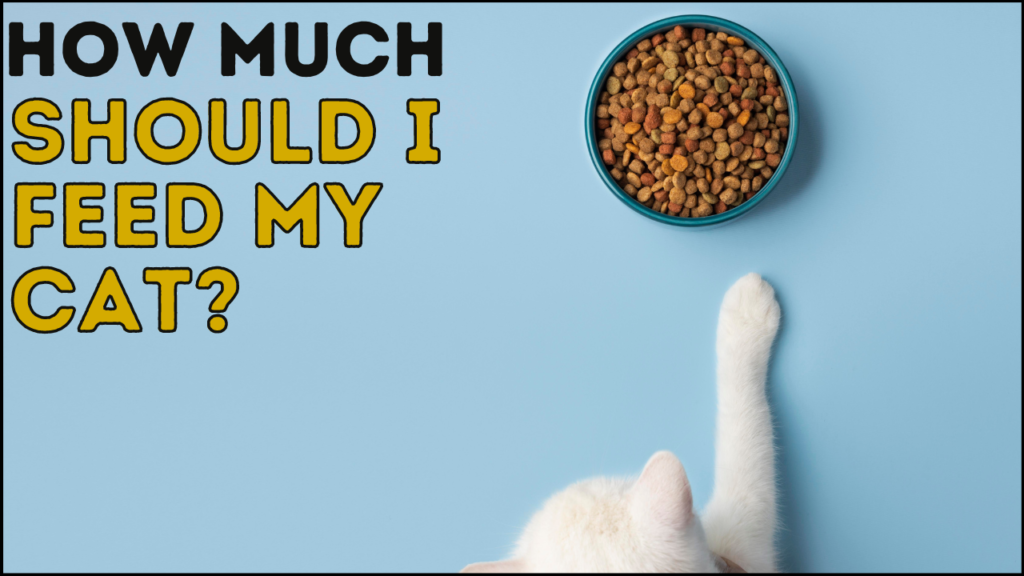
How Much Should I Feed My Cat?
Use an online calculator.
Or check the cat food label for feeding recommendations based on your cats weight.
This is the easiest way to find out how much to feed your cat.
Here is an example:
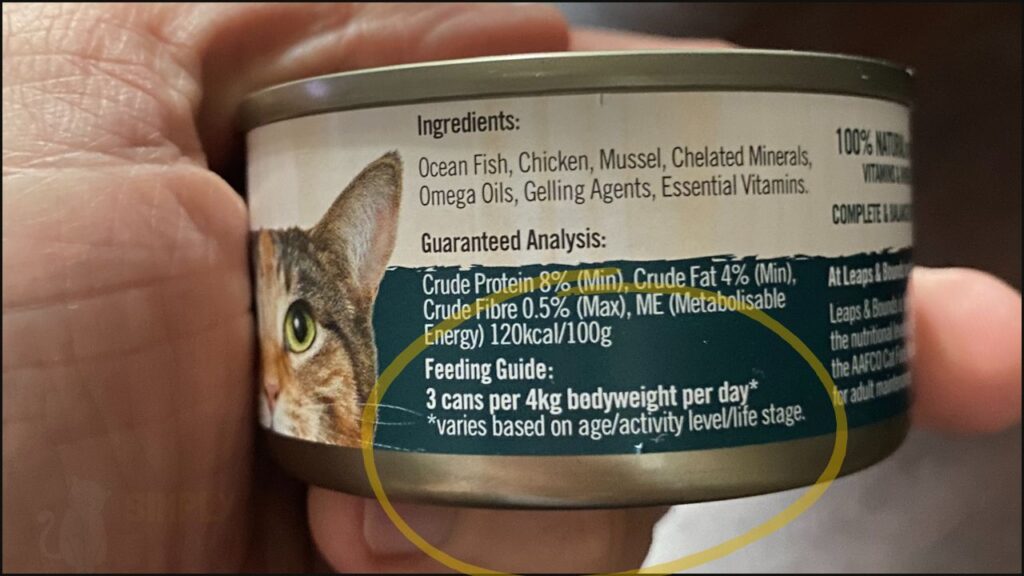
Some are harder to see in the wall of text, but look carefully:
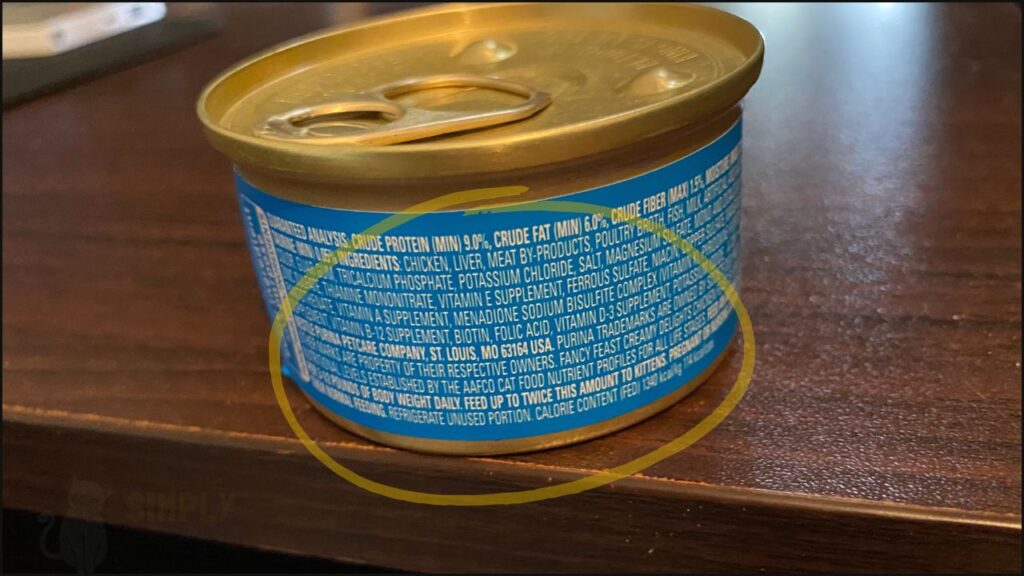
Keep in mind, you won’t get a recommendation if the food is a complete food by AAFCO’s nutrition guidelines.
This is because the food is a supplement and not a sole feeding option.
See an example below:
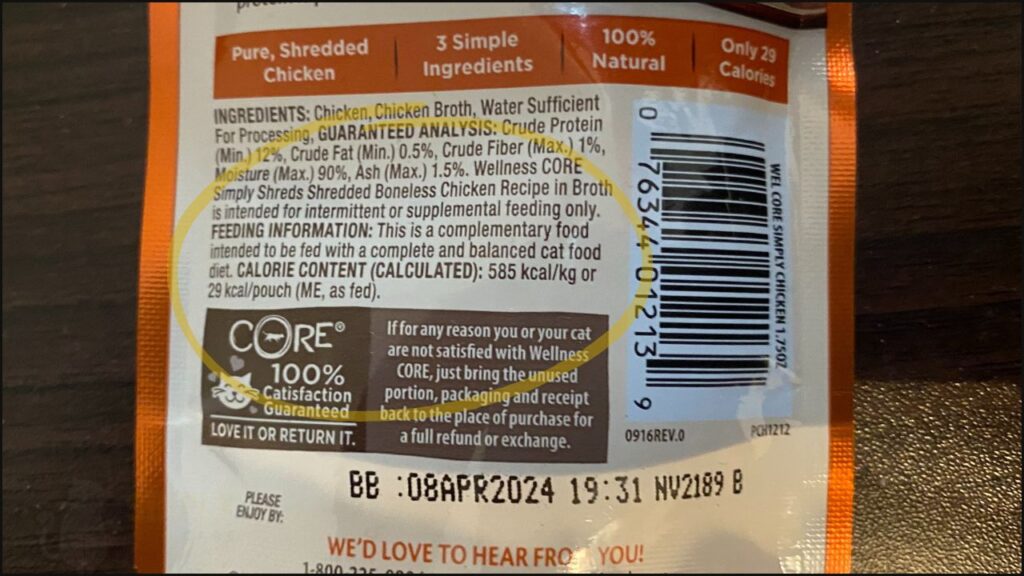
Factors to Consider When Feeding Your Cat
Not every cat is the same.
Some need more food, and some less.
For the most part, it’s your cats weight that determines how many calories they need.
Here are things to consider:
- Age: Middle age cats have a slower metabolism. This means they need less than adult cats. Kittens also need extra food for rapid growth.
- Weight: A higher weight increases food need. However, if your cat is too heavy they’ll need less food for weight loss.
- Activity: Indoor cats tend to get less activity than outdoor cats. This decreases their calorie needs.
- Desexing: Neutered males are at higher risk of gaining weight.
- Health status: Some diseases may require more or less calories. Diabetic cats need less food for weight control.
If using an online calculator, you’ll need to enter the following fields:
- Pet Weight
- Spayed, Neutered, or Intact (select your cat’s de-sexing status)
- Body Condition Score
Let’s talk about each field and how to enter everything into the calculator.
How Do I Weigh My Cat?
Find out your cat’s weight by using the following method:
- Weigh yourself (person weight).
- Hold your cat and weigh yourself (person + cat weight).
- Substract person weight from person + cat weight to find cat’s weight.
Here is an example:
Example
Joe weighs 70kg
Joe holds his cat and stands on the scale – it reads 75kg
Joe’s cat weighs 5kg ( 75-70 = 5)
You need to weigh your cat to find out how much to feed them using the online calculator.
The calculator will ask you to enter your cats body condition score (BCS).
Unlike humans, cats don’t have an ideal ‘weight’ to aim for. Rather it’s more based on visual and physical examination.
You don’t want your cat carrying too much fat, or too little.
That’s the goal.
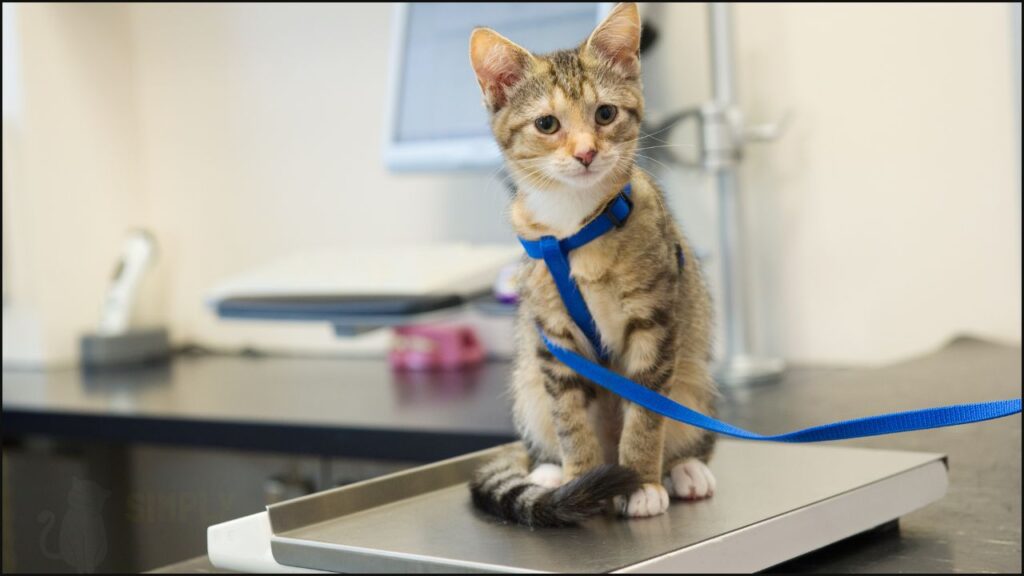
Recommended Feeding Guidelines
Dry Food Vs. Wet Cat Food
Wet food is best for weight control.
Dry cat is 4 x more calorie dense than wet food. This means it’s easy to feed your cat too many calories.
Wet food also has packaging that makes it easier to control food intake. Dry cat food is often free-fed without measuring food.
Whatever the food you use, make sure to follow the instructions on the label and portion food.
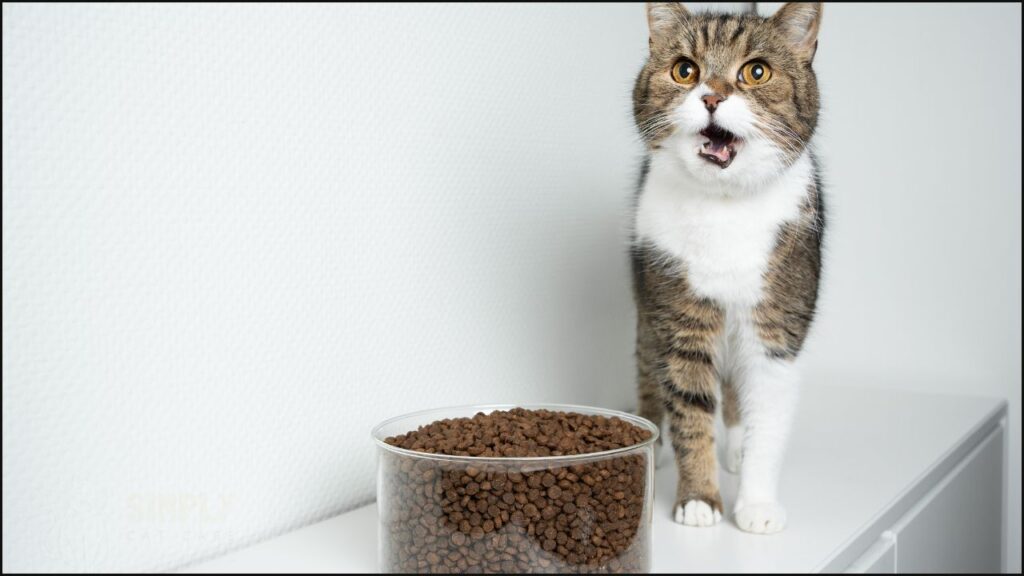
Kittens
Kittens need a high calorie diet for rapid growth.
Most cat food for kittens includes feeding guidelines. AAFCO have nutrition guidelines for growth, which are foods suitable for kittens under one year of age.
For more precision, use an online calculator.
Learn more: Best Wet Kitten Foods
Senior Cats
Use an online calculator.
Energy needs increase at the age of 13 years. An older cat has a higher protein and fat requirement to maintain muscle.
Too little food can lead to a loss of muscle (sarcopenia) and reduce mobility.
Pay careful attention to the BCS and adjust food intake if your senior cat is too low. The Muscle Condition Score chart helps you find out if your cat is losing muscle.
Learn more:
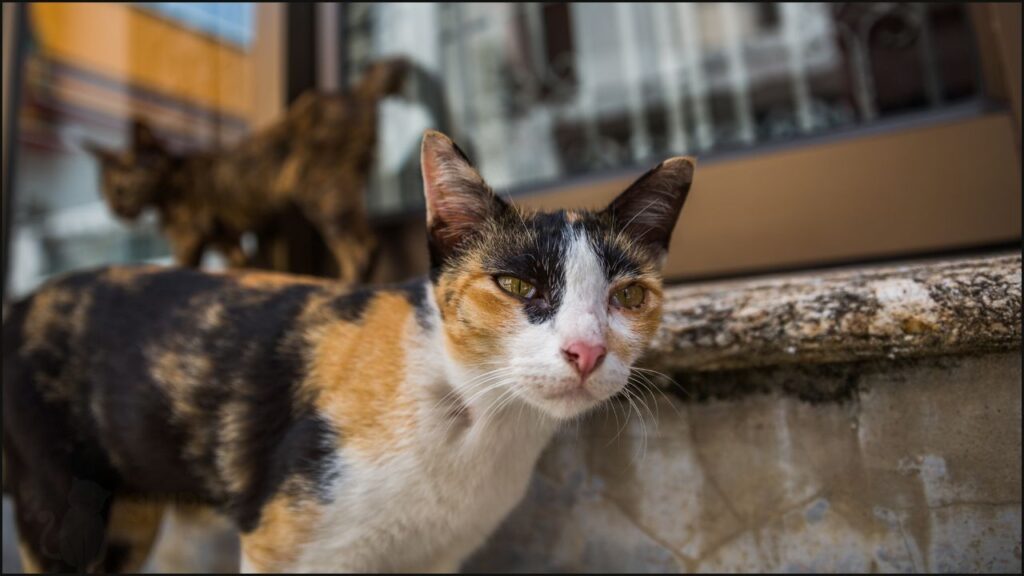
Importance of Monitoring Weight
A balanced weight is best for health.
Overweight cats have a higher risk of diabetes and mobility problems. Being overweight reduces your cat’s chance of living out a long and healthy life.
In 2017, 60% of cats in the US were analyzed as being overweight or obese.
Being too thin can also create health problems for your cat such as loss of muscle mass and increased risk of illness.
Use the Body and Muscle Condition score chart to assess your cat’s condition. The Muscle Condition score chart will help you find out if your cat is losing muscle.
Learn more:
How Do I Calculate How Much To Feed My Cat?
An online calculator or cat food label is the best way to find out what to feed your cat.
However:
You can also manually calculate calories for more precision.
Here’s a step-by-step guide:
1. RESTING ENERGY REQUIREMENT(RER)
The RER is the number of calories a body burns at rest.
Even when your cat is lazing around the house, they still burn calories to fuel body processes such as digestion and thinking.
RER strongly correlates with body weight.
Use the chart below to work out your cat’s RER based on weight.
2. Apply An Activity Factor
An activity factor is a multiplication that adjusts your cat’s energy needs.
A lot of things affect energy needs including age, activity, neutering status.
Use the chart below to apply the necessary activity factor.
Example
My cat weighs 4.5kg. I check the RER chart and see the RER is 218 Calories
I use the factor ‘neutered adult cat’ and multiply this with RER (1.2 x 218 = energy requirement)
That equates to 262 Calories/day.
Remember:
Kittens need more calories per pound than adult cats due to rapid growth.
Also, underweight cats need more calories and vice versa to get to an ideal weight for health.
If you’re having trouble with using the online calculator or the manual calculation method, talk with a vet for help.
3. Putting It Together: How Much To Feed Your Cat
Use the estimated calorie needs from the online calculator or manual calculation to find out how much food to give your cat.
I’ll walk you through this process:
Use the Pet Nutrition Alliance calculator and click on the FOOD tab.
You have three options for working out how much food to feed your cat.
- Calories Per Cup
- Calories Per Can
- Calories Per Kilogram
Here’s what you have to do:
Get your cat food out and look on the label for the nutrition panel on the bag or tin.
Find any of these three numbers and enter that into the calculator.
I picked up a tin of Ziwi Peak East Cape 85g/3oz canned cat food.
The calorie content is 1,500kcal ME/kg.
Here is how this looks in the calculator below.
The calculator suggests I feed my cat 149.25 grams of Ziwi Peak East Cape.
This is slightly less than 2 tins per day.
What I can do is open two tins and weigh out the contents I need into a bowl. The remaining portion can form the next day’s food provision.
Depending on what metric you use, you’ll get a different way of measuring your cat’s food but it will all add up to what they need in terms of calories (i.e. cups, tins, or grams).
However, you might want to use a few different foods over the day and not just one.
For that, you’ll need to do a manual calculation.
Frequently Asked Questions
How Often Should I Feed My Cat?
Kittens
3-4 meals is best for kittens.
The priority for kittens is growth and development.
- 6 – 20 weeks: 200 – 250 kcal/kg
- 4 – 6.5 months: 130 kcal/kg
- 7 – 8.5 months: 100 kcal/kg
- 9 -11 months: 80 kcal/kg
- 12 months: 60 kcal/kg
Adults
2-4 meals is best.
Weight control is the priority in adults.
Feeding 2 – 4 a day increases physical activity, although the benefit is small.
Avoid free-feeding (also called ad-libitum eating).
Indoor cats are at risk of overeating, especially if the environment isn’t stimulating.
Seniors
3-4 meals is best.
After 12 years, cats tend to lose weight to muscle loss. This is due a range of age factors including sarcopenia and reduced digestion of protein.
Small frequent meals are a reasonable choice to help senior cats maintain.
Learn More:
How Much Dry and Wet Food Should I Feed My Cat?
The easiest way to is to check the label (look for ME, the energy content).
All foods vary in how many calories they contain per gram.
An online calculator gives you more precision.
If you feed your cat a mix of both, then make sure to balance things out (e.g. 50% dry and 50% wet). Divvy up calorie needs between the two foods.
It’s easier to start with wet food and see how many calories are in one tin. Then ‘fill the gap’ with dry cat food.
Let’s use an example:
Your cat needs 300 kcal per day. You provide one tin of wet cat food than provides 150 kcal.
Now, you need 150 kcal from dry cat food to ‘fill the gap’.
First, I’ll check the dry cat food.
There is 3,850 kcal/kg in this product.
We need to find out the amount needed for 150 kcal.
Example
How much dry food would we need for 150 kcal?
Since there’s 3,850 kcal in one kg of this food, that means there’s 3.85kcal per 1 gram of food.
We need 150 kcal so that means 150/3.85 = how many grams we need.
That equates to 38.9g of food – which you can round to 39g.
So weigh up 39g of dry cat food and you’re good to go.
Consider divvying that over the day and not putting down in one meal.
Is One Can of Wet Food Enough for a Cat?
One 6 ounce tin of wet cat food is enough for most cats.
However, you’ll likely need 2 or more if using 3 ounce tins or pouches.
Use an online calculator and check the label for more precise recommendations.
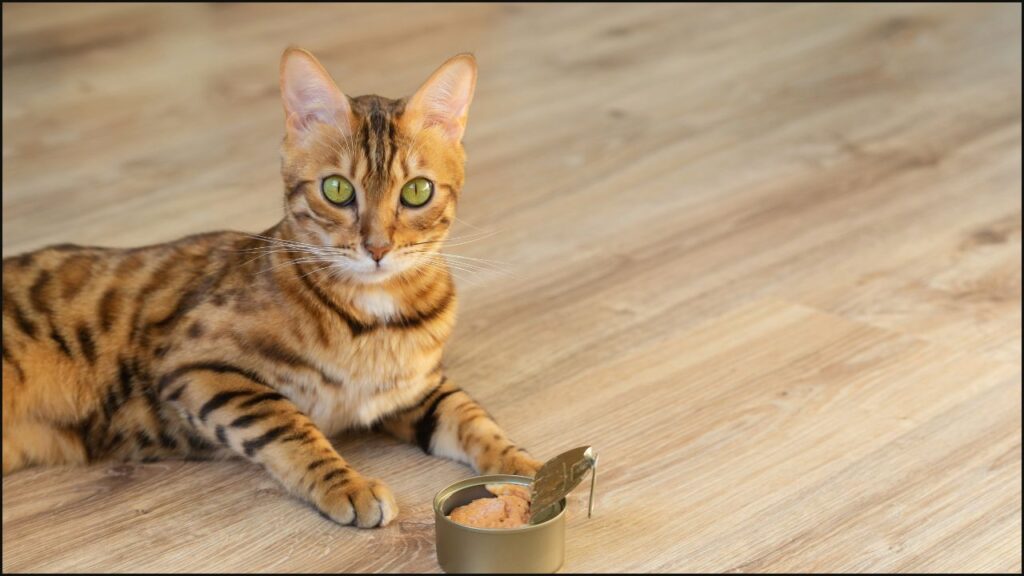
How Do You Know if You’re Feeding Your Cat Enough?
Use the body condition score chart.
This shows you if your cat is carrying too much or too little weight.
You want to aim for a 5 on the chart.
How Much Should I Feed My Cat?
Most cats need around 30 kcal per pound of body weight per day.
Vets recommend feeding your cat between at least two times a day.
In the wild, cats eat 7-20 times a day eating small prey such as mice, birds, and insects. So feeding more small meals may be better than one or two big meals.
Avoid feeding feeding. This means giving your cat free access to food (usually dry) without break. Free feeding increases the risk of obesity.
Is 100g Wet Food Enough for Cats?
No.
Based on our research, the average wet cat food contains about 1,000 kcal/kg.
That means you’d only get 100 kcal in 100g of wet cat food (around 3 ounces).
Most cats need around 192-280 kcal per day. So you’d need around 200g or more to meet the needs of most adult cats.
Is It Ok to Mix Wet and Dry Cat Food Together?
Yes.
Make sure to weigh out the proper amount of both to your cats calorie needs.
Is It Ok to Give Cats Wet Food Everyday?
Yes.
You can feed your cat an all-wet cat food diet. Make sure to check the label to see if it meets AAFCO’s guidelines for nutrition adequacy.
Should I Leave Dry Food Out for My Cat All Day?
No.
Free-feeding is not recommended. This increases the risk of obesity.
Weigh out how much your cat needs and stick to this amount. Consider divvying it up over the day in small portions.
How Many Cups of Dry Cat Food Should I Feed My Cat?
Use the recommended portions on the cat food label.
Or use an online calculator.
All cat food packages have different amounts of calories.
Conclusion
An online calculator or cat food label is the fastest way to find out how much to feed your cat. Most cats need between 190 – 280 kcal per day.
Adjust needs based on your cats age, activity, and weight. Kittens and senior cats need more calories per pound of body weight.
If your cat has another condition, talk with a vet for advice.
>> Check out our 10 best cat foods for health to learn more
